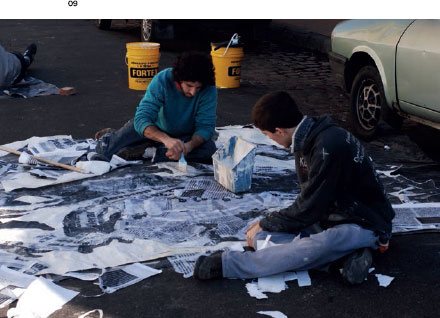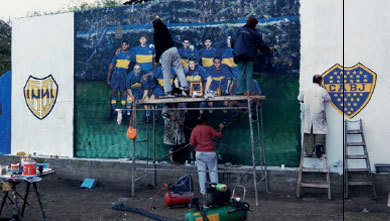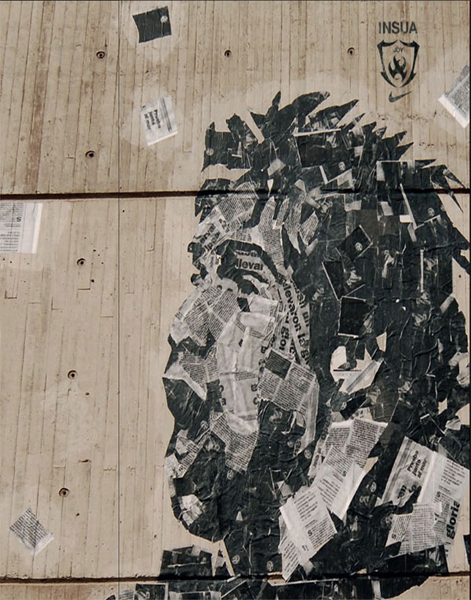Nike
Barrio Bonito
BBDO Argentina
In 2006, BBDO Argentina created the world’s first football neighbourhood, on behalf of its client Nike and in honour of the World Cup. Dubbed Barrio Bonito (‘beautiful neighbourhood’) the project was created in La Boca, a run-down area of Buenos Aires that is famed for being the home of Boca Juniors, one of the world’s most famous football clubs. Barrio Bonito formed part of Nike’s global Jogo Bonito (‘beautiful play’) advertising campaign, though was first inspired by a localized dilemma created by the global strategy, as BBDO Argentina President Carlos Pérez explains: ‘Barrio Bonito was born from the context of the 2006 World Cup in response to a little “problem” that was happening to our brand, our country and the competition.’
01 In the build-up to the World Cup in 2006, BBDO Argentina created a ‘football neighbourhood’ on behalf of Nike in La Boca, Buenos Aires. Barrio Bonito featured various artworks created by local artists, including this giant newspaper portrait of Argentine footballer Emiliano Insúa.
‘The concept of the global campaign that Nike planned for the most important event in soccer on a global level was Jogo Bonito,’ he continues, ‘a concept that speaks of the Brazilian magic and beauty of soccer. The entire campaign focused on turning the Brazilian game into an idol and making the style universally known. This is something strategically intelligent, as Brazilian soccer is admired all over the world. Everywhere except Argentina. Argentina and Brazil are friends and neighbours until it comes to soccer. Simply put, it was impossible to have a campaign in Argentina during the World Cup referring to Jogo Bonito without being classified as a traitor. Additionally it was dangerous what adidas, the historic sponsor of the Argentina team, could have done with that concept. It was clear we had to do something.’
Out of this adverse situation, an impressive piece of site-specific advertising was born. BBDO Argentina chose La Boca as the destination for its Nike football neighbourhood, both for its footballing heritage but also for its strong artistic links. ‘Barrio Bonito was built in the only place on earth possible: La Boca,’ says Pérez. ‘Boca is the neighbourhood in which River Plate and Boca Juniors were born, two of the most important football teams in Argentina. A humble riverside town, where everything is painted in bright colours. Ancient legend says the first settlers didn’t have enough money to buy all the same colour paint, so they depended on factory surplus. It is also the birthplace of most of our great artists – it is estimated that there are more than 4,000 artists living in the neighbourhood.’
While the idea of a ‘Nike neighbourhood’ may seem obnoxious to many, BBDO Argentina’s intention was to be subtle and respectful. Rather than simply placing Nike logos all over the area, they instead wanted to bring something artistic and relevant to La Boca. A number of run-down buildings in the area were consequently renovated and repainted as part of the campaign, and football-related artworks placed in the area. These include murals of Nike football stars such as Argentinean players Carlos Tévez and Sergio Agüero, as well as Brazilian player Ronaldinho (perhaps a slightly risky move in an Argentinean football stronghold).
‘It was impossible to have a campaign in Argentina during the World Cup referring to Jogo Bonito without being classified as a traitor. Additionally it was dangerous what adidas, the historic sponsor of the Argentina team, could have done with that concept. It was clear we had to do something.’


02-03 A newspaper portrait of Argentine footballer Sergio Agüero was another of the artworks featured in the Barrio Bonito.
04 Posts in the neighbourhood were painted with images of players to encourage local footballers to practise their dribbling skills around them.


05-06 The La Boca neighbourhood has a strong artistic heritage, alongside its links to football. Local artists are shown here helping to create the large artworks that are displayed in the area.
07 Among the artworks is a football pitch containing a number of statues of England players from the 1986 World Cup quarter-final. Visitors are encouraged to recreate Diego Maradona’s controversial ‘hand of God’ goal from the match, using the figures as props.
08 Portrait of Ronaldinho, designed to appear as if it has been created from ballprints.




9-12 Artists at work on the various murals and artworks featured in the neighbourhood.
‘The principal intention of Barrio Bonito was to benefit the residents and leave a legacy for the city and the country. All the work included the participation of local artists approved by local residents.’

13-14 Visitors inspect the statues of the England players, while a young footballer tries out the posts in Barrio Bonito.
There is also a large sculptural work that may prove uncomfortable viewing for English tourists – a courtyard filled with life-size statues of England players, around which visitors are encouraged to re-enact Maradona’s notorious ‘hand of God’ goal from the Mexico 1986 World Cup quarter-final. ‘We wanted to neutralize any negative effect [of the Jogo Bonito campaign],’ continues Pérez, ‘and most of all capture the essence of the brand with respect to football, which fits perfectly with the Argentine feeling towards football: a love, a passion and, most of all, a taste for beautiful football that is unmatched, even in Brazil.’
Local artists were involved in the making of Barrio Bonito, and the city government of Buenos Aires backed the project, with the site being officially opened by the mayor in May 2006. ‘The principal intention of Barrio Bonito was to benefit the residents and leave a legacy for the city and the country,’ explains Pérez. ‘All the work included the participation of local artists approved by local residents.’
Much of the artwork is still in place today, with Barrio Bonito continuing to be a tourist attraction in the city. ‘The majority of the work still remains, with the advertising things eliminated,’ says Pérez. ‘I feel very proud of the Barrio Bonito work, as it made La Boca a better neighbourhood.’





